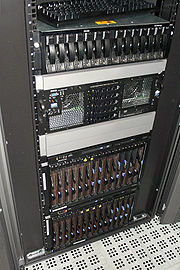Web server
From Wikipedia, the free encyclopedia
| This article does not cite any references or sources. Please help improve this article by adding citations to reliable sources (ideally, using inline citations). Unsourced material may be challenged and removed. (March 2009) |

The term web server can mean one of two things:
- A computer program that is responsible for accepting HTTP requests from clients (user agents such as web browsers), and serving them HTTP responses along with optional data contents, which usually are web pages such as HTML documents and linked objects (images, etc.).
- A computer that runs a computer program as described above.
Contents |
[edit] Common features
Although web server programs differ in detail, they all share some basic common features.
- HTTP: every web server program operates by accepting HTTP requests from the client, and providing an HTTP response to the client. The HTTP response usually consists of an HTML document, but can also be a raw file, an image, or some other type of document (defined by MIME-types). If some error is found in client request or while trying to serve it, a web server has to send an error response which may include some custom HTML or text messages to better explain the problem to end users.
- Logging: usually web servers have also the capability of logging some detailed information, about client requests and server responses, to log files; this allows the webmaster to collect statistics by running log analyzers on these files.
In practice many web servers implement the following features also:
- Authentication, optional authorization request (request of user name and password) before allowing access to some or all kind of resources.
- Handling of static content (file content recorded in server's filesystem(s)) and dynamic content by supporting one or more related interfaces (SSI, CGI, SCGI, FastCGI, JSP, PHP, ASP, ASP.NET, Server API such as NSAPI, ISAPI, etc.).
- HTTPS support (by SSL or TLS) to allow secure (encrypted) connections to the server on the standard port 443 instead of usual port 80.
- Content compression (i.e. by gzip encoding) to reduce the size of the responses (to lower bandwidth usage, etc.).
- Virtual hosting to serve many web sites using one IP address.
- Large file support to be able to serve files whose size is greater than 2 GB on 32 bit OS.
- Bandwidth throttling to limit the speed of responses in order to not saturate the network and to be able to serve more clients.
[edit] Origin of returned content
The origin of the content sent by server is called:
- static if it comes from an existing file lying on a filesystem;
- dynamic if it is dynamically generated by some other program or script or application programming interface (API) called by the web server.
Serving static content is usually much faster (from 2 to 100 times) than serving dynamic content, especially if the latter involves data pulled from a database.
[edit] Path translation
Web servers are able to map the path component of a Uniform Resource Locator (URL) into:
- a local file system resource (for static requests);
- an internal or external program name (for dynamic requests).
For a static request the URL path specified by the client is relative to the Web server's root directory.
Consider the following URL as it would be requested by a client:
http://www.example.com/path/file.html
The client's web browser will translate it into a connection to www.example.com with the following HTTP 1.1 request:
GET /path/file.html HTTP/1.1 Host: www.example.com
The web server on www.example.com will append the given path to the path of its root directory. On Unix machines, this is commonly /var/www. The result is the local file system resource:
/var/www/path/file.html
The web server will then read the file, if it exists, and send a response to the client's web browser. The response will describe the content of the file and contain the file itself.
[edit] Load limits
A web server (program) has defined load limits, because it can handle only a limited number of concurrent client connections (usually between 2 and 60,000, by default between 500 and 1,000) per IP address (and TCP port) and it can serve only a certain maximum number of requests per second depending on:
- its own settings;
- the HTTP request type;
- content origin (static or dynamic);
[edit] Historical notes
In 1989 Tim Berners-Lee proposed to his employer CERN (European Organization for Nuclear Research) a new project, which had the goal of easing the exchange of information between scientists by using a hypertext system. As a result of the implementation of this project, in 1990 Berners-Lee wrote two programs:
- a browser called WorldWideWeb;
- the world's first web server, later known as CERN HTTPd, which ran on NeXTSTEP.
Between 1991 and 1994 the simplicity and effectiveness of early technologies used to surf and exchange data through the World Wide Web helped to port them to many different operating systems and spread their use among lots of different social groups of people, first in scientific organizations, then in universities and finally in industry.
In 1994 Tim Berners-Lee decided to constitute the World Wide Web Consortium to regulate the further development of the many technologies involved (HTTP, HTML, etc.) through a standardization process.
The following years are recent history which has seen an exponential growth of the number of web sites and servers.
[edit] Market structure
Given below is a list of top Web server software vendors published in a Netcraft survey in January 2009.
| Vendor | Product | Web Sites Hosted | Percent |
|---|---|---|---|
| Apache | Apache | 96,531,033 | 52.05% |
| Microsoft | IIS | 61,023,474 | 32.90% |
| GWS | 9,864,303 | 5.32% | |
| nginx | nginx | 3,462,551 | 1.87% |
| lighttpd | lighttpd | 2,989,416 | 1.61% |
| Oversee | Oversee | 1,847,039 | 1.00% |
| Others | - | 9,756,650 | 5.26% |
| Total | - | 185,474,466 | 100.00% |
See Category:Web server software for a longer list of HTTP server programs.
[edit] See also
- List of web server and hosting companies
- Application server
- Comparison of web servers
- HTTP compression
- Open source web application
- SSI, CGI, SCGI, FastCGI, PHP, Java Servlet, JavaServer Pages, ASP, ASP .NET, Server API
- Tiny web servers
- Virtual hosting
- Web hosting service
- Web service
[edit] External links
- RFC 2616, the Request for Comments document that defines the HTTP 1.1 protocol.
- C64WEB.COM - Commodore 64 running as a webserver using Contiki
|
||||||||||||||



